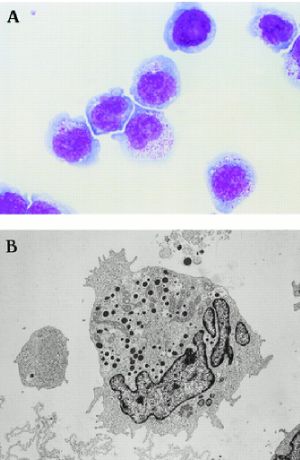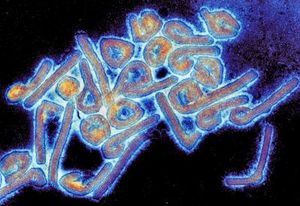Natural Killer Cell: Difference between revisions
| Line 1: | Line 1: | ||
==Overview== | ==Overview== | ||
[[Image:NK.cells.EM.LM.jpg|thumb|300px|right|Natural killer cells (NK cells) under light microscopy (A) and electron microscopy (B). In <i> | [[Image:NK.cells.EM.LM.jpg|thumb|300px|right|Natural killer cells (NK cells) under light microscopy (A) and electron microscopy (B). In <i>Characterization of a Novel Human Natural Killer-Cell Line (NK-YS) Established From Natural Killer Cell Lymphoma/Leukemia Associated With Epstein-Barr Virus Infection (Tsuchiyama J. et al. 1998)</i>. Link:https://ashpublications.org/blood/article/92/4/1374/247309/Characterization-of-a-Novel-Human-Natural-Killer]] | ||
Natural killer cells ( | Natural killer cells (NK cells) are a type of granular cytotoxic lymphocytes that are non-adherent and non-phagocytic. NK cells were originally defined as a subset of lymphocytes that have natural cytotoxic activity against certain types of tumorous cells and endogenous type-C viruses in mice. Natural cytotoxicity refers to the fact that they can rapidly cause tumor cells’ lyses in the absence of any previous stimulation [1,2]. They were first named in an article in 1976 [3] and later categorized as part of the innate immune system due to their morphology, origin (bone marrow), and lack of antigen-specific receptors (such as those on T and B-cells’ surfaces) and their respective genes. [4,5] | ||
[[Image:marburgvirus.jpg|thumb|300px|right|Colony of Marburg virus. Transmission electron microscope image taken by Dr. Tom Geisbert]] | [[Image:marburgvirus.jpg|thumb|300px|right|Colony of Marburg virus. Transmission electron microscope image taken by Dr. Tom Geisbert]] | ||
Revision as of 04:12, 2 December 2019
Overview

Natural killer cells (NK cells) are a type of granular cytotoxic lymphocytes that are non-adherent and non-phagocytic. NK cells were originally defined as a subset of lymphocytes that have natural cytotoxic activity against certain types of tumorous cells and endogenous type-C viruses in mice. Natural cytotoxicity refers to the fact that they can rapidly cause tumor cells’ lyses in the absence of any previous stimulation [1,2]. They were first named in an article in 1976 [3] and later categorized as part of the innate immune system due to their morphology, origin (bone marrow), and lack of antigen-specific receptors (such as those on T and B-cells’ surfaces) and their respective genes. [4,5]
At right is a sample image insertion. It works for any image uploaded anywhere to MicrobeWiki. The insertion code consists of:
Double brackets: [[
Filename: PHIL_1181_lores.jpg
Thumbnail status: |thumb|
Pixel size: |300px|
Placement on page: |right|
Legend/credit: Electron micrograph of the Ebola Zaire virus. This was the first photo ever taken of the virus, on 10/13/1976. By Dr. F.A. Murphy, now at U.C. Davis, then at the CDC.
Closed double brackets: ]]
Other examples:
Bold
Italic
Subscript: H2O
Superscript: Fe3+
Section 1 Genetics
Include some current research, with at least one image.
Sample citations: [1]
[2]
A citation code consists of a hyperlinked reference within "ref" begin and end codes.
Section 2 Microbiome
Include some current research, with a second image.
Conclusion
Overall text length should be at least 1,000 words (before counting references), with at least 2 images. Include at least 5 references under Reference section.
References
Edited by [Minh Pham], student of Joan Slonczewski for BIOL 116 Information in Living Systems, 2019, Kenyon College.

